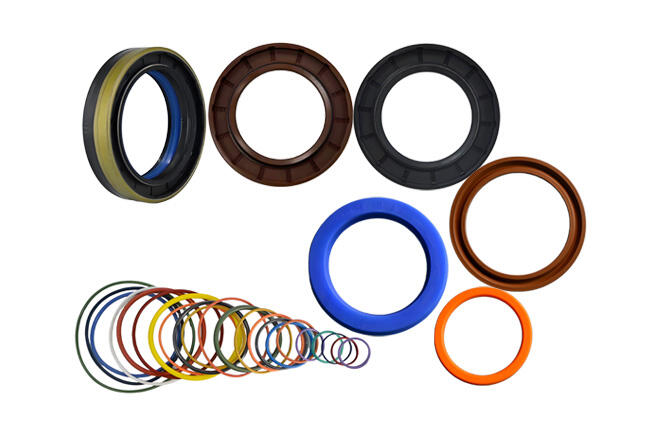In the world of hydraulic machinery, when a single O-ring or rod seal gives out, the result can be a sudden drop in pressure, equipment downtime, or even a costly safety risk. In heavy-duty industrial systems, sealing is not a minor concern but the backbone of long-term reliability. Understanding how to select and maintain seals within a hydraulic environment is, therefore, one of the most practical skills an engineer or distributor can have.
Why Hydraulic Systems Depend on Sealing Integrity
Hydraulic power relies on the controlled movement of fluid under high pressure. Any leakage means loss of efficiency and contamination risk. A well-designed sealing system keeps the oil inside, dust and moisture outside, and ensures smooth reciprocating or rotary motion of pistons, rods, and shafts.
What makes this challenging is the variety of conditions: pressures that often exceed 30 MPa, temperature swings between -30°C and +120°C, and exposure to hydraulic oils or synthetic fluids. The seal must perform consistently while enduring friction, vibration, and micro-movement along metal surfaces. A single mismatch between seal material and fluid medium can shorten service life dramatically.
Key Seal Types in Hydraulic Systems
Hydraulic equipment typically uses a combination of static and dynamic seals.
O-rings provide basic static sealing, often paired with backup rings to prevent extrusion.
Rod seals and piston seals control internal fluid leakage, maintaining pressure between system chambers.
Wipers or scrapers protect the system from external contamination.
Wear rings stabilize the movement of pistons and rods, reducing side load on the primary seals.
Each of these components must work as part of a balanced design. Using one high-quality part does not guarantee reliability if the surrounding elements are mismatched or installed incorrectly.

Material Selection
Choosing the right sealing material is a blend of chemistry, physics, and field experience.
NBR (Nitrile Rubber) remains the most cost-effective option for standard hydraulic oils and moderate temperatures.
HNBR (Hydrogenated Nitrile) provides better resistance to heat and chemical degradation.
FKM (Fluoroelastomer) is preferred in systems using aggressive synthetic fluids or higher temperatures.
PTFE (Polytetrafluoroethylene) and polyurethane are common in dynamic applications requiring low friction and wear resistance.
The best results often come from compound customization—adapting hardness, fillers, or lip geometry to the actual working conditions. In modern systems, dual-material designs are becoming more common: a rigid backup ring combined with a flexible lip, or a PTFE sealing edge supported by an elastomer base.
Common Challenges in Real Applications
In actual use, seal performance is influenced by far more than just material. Surface roughness, groove tolerances, and even installation practices play major roles.
For example, a rod that’s slightly misaligned can create uneven contact pressure, leading to premature lip wear. Similarly, using the wrong lubricant during installation may cause chemical swelling.
Distributors and maintenance teams often ask: “Is there a universal seal that can handle everything?” Unfortunately, no. Hydraulic systems vary widely — from mobile excavators to precision injection molding machines. Each setup requires a tailored sealing configuration that balances flexibility, chemical compatibility, and mechanical endurance.
5Considerations for Distributors and Buyers
For wholesalers and OEM buyers, the top concerns usually revolve around lead time, consistency, and after-sales reliability. That’s where companies like NQKSF provide a practical advantage.
The company maintains a broad inventory covering more than ten thousand seal specifications, ensuring standard parts can be shipped immediately to meet urgent replacement needs. For non-standard seals, its customization service supports customers from material selection to prototype validation, ensuring the final product precisely matches the operating environment.
Drawing on over 30 years of field experience, NQKSF’s engineering team helps optimize sealing systems, reducing maintenance frequency and overall operational cost — a significant benefit for clients managing multiple hydraulic lines or high-volume production equipment.
Reliability Through Manufacturing and Innovation
Behind each reliable seal is a manufacturing ecosystem that values precision.
NQKSF operates as a fully equipped physical factory, integrating design, tooling, and testing under one roof. Its extensive catalog supports both domestic and global markets, with products shipped to over 80 countries.
The company is recognized as a provincial-level technology innovation center, specialized and innovative enterprise, and part of a regional industrial cluster known for material research and process excellence.
For distributors, this means stable supply, clear traceability, and confidence when reselling to critical industries such as hydraulics, energy, and heavy machinery.
Practical Tips for Longer Seal Life
To extend seal life in hydraulic systems:
Maintain shaft surface roughness between Ra 0.2–0.4 µm.
Avoid over-tightening metal housings during installation.
Use compatible lubricants during assembly.
Regularly inspect wipers and backup rings to prevent secondary failures.
Following these small steps often saves hours of downtime and thousands in maintenance cost. It’s not the seal’s price that determines system performance, it’s the attention to these practical details.
Hydraulic sealing may look like a minor technical topic, but its impact reaches every part of an industrial system. From a distributor’s shelf to an OEM production line, the quality and selection of seals influence uptime, energy efficiency, and customer trust.
Whether it’s a standard O-ring or a customized hydraulic set, success depends on choosing the right material, ensuring precision manufacturing, and working with experienced partners.
 Hot News
Hot News